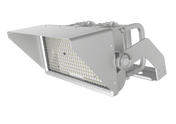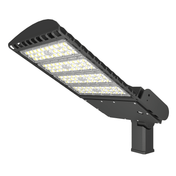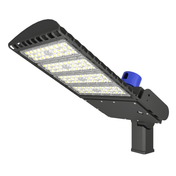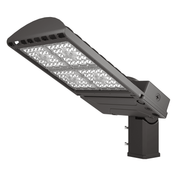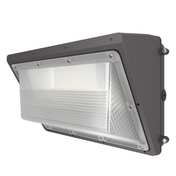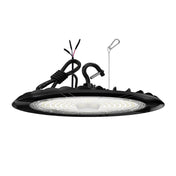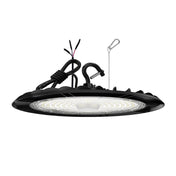Warehouse lighting is far more than a matter of "brightening up space"—it directly impacts operational efficiency, employee safety, and long-term cost control. A well-lit warehouse can reduce picking errors by up to 30%, lower accident rates by 40%, and cut energy consumption by half with the right technology. With the evolution of lighting tech, warehouse managers now have more options than ever to balance performance, cost, and sustainability. This blog breaks down the main types of warehouse lighting, their pros and cons, and how to choose the best fit for your space.
1. Traditional Warehouse Lighting: The "Transitional" Options
Before the rise of LED and smart systems, traditional lighting technologies dominated the warehouse industry. While they are gradually being phased out, many older facilities still rely on them—making it critical to understand their limitations when planning upgrades.
a. High-Pressure Sodium (HPS) Lamps
High-pressure sodium lamps were once a staple in large warehouses and outdoor yards. They work by passing an electric current through sodium vapor, producing a warm yellow-orange light.
Advantages: Low initial cost and high luminous flux (up to 150 lumens per watt), which made them suitable for high-ceiling spaces (15m+). Their long lifespan (10,000–24,000 hours) also made them a practical choice for hard-to-reach areas.
Disadvantages: Poor color rendering index (CRI < 20), meaning they distort colors, critical for tasks like picking colored products or inspecting goods. They also take 5–10 minutes to reach full brightness (a major issue during power outages) and consume more energy over time. Additionally, their mercury content makes disposal costly and environmentally risky.
Best for: Temporary use in outdoor storage yards or older warehouses with minimal color-dependent tasks (e.g., bulk metal storage).
b. Metal Halide (MH) Lamps
Metal halide lamps are an improvement over HPS in terms of color quality. They combine metal halide salts with mercury vapor to produce a white light, making them popular for medium-height warehouses (8–12m) in the 2000s.
Advantages: Higher CRI (60–80) than HPS, allowing better color recognition for picking or quality control. They also have a faster startup time (1–2 minutes) and brighter light output (up to 120 lumens per watt).
Disadvantages: Short lifespan (6,000–15,000 hours) and high maintenance costs—their bulbs and ballasts need frequent replacement. They also suffer from "lumen depreciation" (losing 30% brightness after 5,000 hours) and are sensitive to temperature changes (performance drops in cold warehouses).
Best for: Older warehouses undergoing gradual upgrades, or facilities with moderate ceiling heights and occasional color-dependent tasks (e.g., electronics storage).
c. Fluorescent Tubes
Fluorescent tubes (including T5 and T8 models) were once common in low-ceiling warehouses (4–6m) due to their compact design. They work by exciting mercury vapor to produce UV light, which then glows through a phosphor coating.
Advantages: Low upfront cost, instant startup, and better CRI (70–85) than HPS/MH. They are also dimmable, making them suitable for areas with variable lighting needs (e.g., packing stations).
Disadvantages: Short lifespan (8,000–12,000 hours) and high energy consumption (only 50–80 lumens per watt). Their mercury content requires special disposal, and they perform poorly in cold environments (below 10°C), which is a problem for refrigerated warehouses.
Best for: Small, low-ceiling warehouses with limited budgets and no cold-storage needs—though they are increasingly replaced by LED alternatives.
2. LED Lighting: The Modern Warehouse’s Go-To Choice
In the past decade, LED (Light-Emitting Diode) lighting has become the gold standard for new warehouses and retrofits. Its combination of energy efficiency, long lifespan, and versatility addresses nearly all the flaws of traditional lighting.
How LED Warehouse Lighting Works
LEDs produce light by passing a current through a semiconductor, which emits photons—no mercury, no heat waste, and no slow startup. For warehouses, LED fixtures are typically designed as "high-bay" (for 8m+ ceilings) or "low-bay" (for 4–8m ceilings) models, with options for wide or narrow beam angles to target specific areas.
Key Advantages of LED Warehouse Lighting
-
Unmatched Energy Efficiency: LEDs deliver 120–200 lumens per watt—50–70% more efficient than HPS/MH and 30% more than fluorescent tubes. A 10,000 sq. ft. warehouse switching to LEDs can save $$5,000$$15,000 annually on electricity.
-
Long Lifespan: 50,000–100,000 hours (5–10 years of 24/7 use) vs. 10,000 hours for HPS. This cuts maintenance costs by 80%—critical for high-ceiling warehouses where bulb replacement requires lifts or scaffolding.
-
Superior CRI: Most warehouse LEDs have a CRI of 80–90, ensuring accurate color recognition for picking, sorting, and quality checks. Some high-end models (CRI 90+) are used in pharmaceutical or food warehouses where color accuracy is non-negotiable.
-
Cold-Resistant: LEDs perform perfectly in temperatures as low as -40°C, making them ideal for refrigerated warehouses (a major advantage over fluorescent tubes).
-
Instant On/Off: No warm-up time, which improves safety during power outages or shift changes.
Common LED Warehouse Fixture Types
-
LED High-Bay Lights: For ceilings 8–20m high (e.g., pallet racking areas). They have narrow beam angles (15–60°) to focus light downward, avoiding glare.
-
LED Low-Bay Lights: For ceilings 4–8m (e.g., packing stations, office-adjacent areas). Wider beam angles (60–120°) provide even coverage.
-
LED Linear Lights: Long, slim fixtures for aisleways or conveyor belts. They cast uniform light along narrow spaces, reducing shadows that hide small items.
-
LED UFO Lights: Compact, circular high-bay fixtures with a "flying saucer" design. They are easy to install and resistant to dust/moisture (IP65 rating), making them popular for dusty warehouses (e.g., construction material storage).
Best for: Nearly all warehouses—new builds, retrofits, cold storage, or high-ceiling facilities. They are the most cost-effective choice over 5 years, even with higher upfront costs.
3. Smart Warehouse Lighting Systems: The IoT-Driven Efficiency Revolution
As warehouses adopt automation (e.g., AGVs, robotics) and IoT technology, smart lighting systems have emerged as a game-changer. These systems don’t just "light up"—they adapt to real-time needs, integrate with other warehouse tools, and provide data to optimize operations.
Core Components of Smart Warehouse Lighting
-
Sensors: Motion sensors (detecting human/AGV movement), daylight sensors (adjusting brightness based on natural light), and temperature/humidity sensors (monitoring environmental conditions).
-
Wireless Connectivity: Zigbee, Bluetooth, or LoRaWAN protocols link fixtures to a central controller or cloud platform.
-
Central Management Software: Allows remote control (turning lights on/off, dimming) and data analysis (energy usage, fixture health, occupancy patterns).
Key Benefits of Smart Lighting
-
Further Energy Savings: By dimming or turning off lights in unoccupied areas (e.g., empty aisles), smart systems cut energy use by an additional 20–30% on top of LED efficiency.
-
Predictive Maintenance: The software alerts managers when fixtures are about to fail (based on usage hours or performance data), avoiding unexpected downtime.
-
Integration with Warehouse Tech: Smart lights can sync with AGVs or WMS (Warehouse Management Systems)—for example, brightening the path of an AGV or dimming lights in areas marked "closed" in the WMS.
-
Occupancy Insights: Data on which areas are most used helps optimize layout (e.g., moving frequently picked items to well-lit, high-traffic zones).
Best for: Automated warehouses, large facilities (100,000+ sq. ft.), or warehouses with variable occupancy (e.g., peak seasons vs. slow periods). They are also ideal for companies aiming for LEED certification or carbon neutrality.
How to Choose the Right Warehouse Lighting
With so many options, the key is to align lighting with your warehouse’s unique needs. Here’s a step-by-step guide:
-
Assess Ceiling Height: High-bay LEDs (8m+) or HPS (temporary) for tall spaces; low-bay LEDs or linear LEDs for shorter ceilings.
-
Prioritize Tasks: Need color accuracy? Choose LEDs with CRI 85+. Cold storage? Avoid fluorescent tubes—opt for cold-resistant LEDs.
-
Calculate Total Cost of Ownership (TCO): Don’t just look at upfront costs—LEDs cost more initially but save 50% on energy and 80% on maintenance over 5 years. Smart systems add TCO value via further savings.
-
Check Environmental Ratings: For dusty or wet warehouses (e.g., food processing), choose fixtures with IP65+ (dust-tight, water-resistant) or IP67 (submersible) ratings.
-
Plan for Scalability: If you’re expanding or adding automation, choose smart LED systems that can grow with your warehouse.
The Future of Warehouse Lighting
The next frontier in warehouse lighting will focus on sustainability and integration. We’re already seeing:
-
Solar-Powered LED Systems: Reducing grid dependency for outdoor yards or remote warehouses.
-
AI-Driven Adaptive Lighting: Systems that learn occupancy patterns and adjust brightness automatically (e.g., dimming during slow shifts, brightening during peak hours).
-
Li-Fi Integration: Using light waves to transmit data (faster than Wi-Fi) for AGVs or IoT devices—turning lighting fixtures into communication hubs.
Conclusion
Warehouse lighting has evolved from a "one-size-fits-all" utility to a tailored solution that boosts efficiency, safety, and sustainability. Traditional options like HPS and fluorescent tubes are fading, while LEDs have become the standard for most facilities. For forward-thinking warehouses, smart lighting systems offer even greater control and savings. By understanding your space’s height, tasks, and long-term goals, you can choose lighting that doesn’t just illuminate— but enhances your entire operation.
Whether you’re retrofitting an old warehouse or building a new one, the right lighting investment will pay off in lower costs, happier employees, and smoother workflows for years to come.


